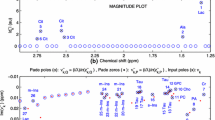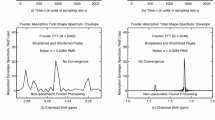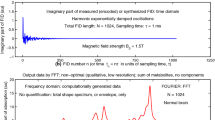Abstract
We perform mathematical modeling with the fast Padé transform (FPT) according to magnetic resonance (MR)-time signals as encoded in vitro from normal glandular and stromal prostate tissue and from prostate cancer. This is one of the most demanding signal processing problems in MR spectroscopy due to the abundance of diagnostically important multiplets (notably doublet and triplet resonances). The FPT provided exact reconstruction at short acquisition times (i.e. using only a fraction of the full signal length) of all the input spectral parameters for the data corresponding to prostate cancer and to normal glandular as well as stromal prostate tissue. This was achieved without any fitting or numerical integration of peak areas. The converged parametric results remained stable at longer partial signal lengths, including the case using the full signal length. The Padé absorption component spectra yielded unequivocal resolution of all the extracted physical resonances, including multiplet resonances and closely overlapping peaks of different metabolites. The capacity of the FPT to resolve and precisely quantify the physical resonances as encountered in normal tissue from two distinct regions of the prostate, as well as in prostate cancer is demonstrated. The spectra from prostate tissues are dense, which suggests that there is a rich array of metabolic information to be gleaned. The FPT is hereby shown to be optimally suited to retrieve that information. The FPT reliably yields the metabolite concentrations that could be of critical importance for distinguishing non-malignant from cancerous prostate tissue. Padé-optimized MRS could clearly aid prostate cancer diagnostics. This line of investigation will continue with experimentally encoded data from normal, hypertrophic and cancerous prostate tissue, in vitro and in vivo. We anticipate that Padé-optimized MRS will improve the specificity as well as sensitivity of MR-based modalities with respect to prostate cancer. This could have an important impact upon timely and accurate diagnosis of this malignancy, as well as aiding decision-making for therapeutic dilemmas.
Similar content being viewed by others
Abbreviations
- Ala:
-
Alanine
- au:
-
Arbitrary units
- Cit:
-
Citrate
- Cho:
-
Choline
- Cr:
-
Creatine
- DRE:
-
Digital rectal examination
- FID:
-
Free induction decay
- FFT:
-
Fast Fourier transform
- FPT:
-
Fast Padé transform
- FWHM:
-
Full width at half maximum
- GPC:
-
Glycerophosphocholine
- HLSVD:
-
Hankel-Lanczos Singular Value Decomposition
- HRMAS:
-
High-resolution magic-angle spinning
- Lac:
-
Lactate
- m-Ino:
-
Myoinositol
- MR:
-
Magnetic resonance
- MRI:
-
Magnetic resonance imaging
- MRS:
-
Magnetic resonance spectroscopy
- MRSI:
-
Magnetic resonance spectroscopic imaging
- PA:
-
Polyamines
- PC:
-
Phosphocholine
- ppm:
-
Parts per million
- PSA:
-
Prostate specific antigen
- s-Ino:
-
Scyllo-inositol
- SNR:
-
Signal-to-noise ratio
- SNS:
-
Signal-noise separation
- Tau:
-
Taurine
- TE:
-
Echo time
- TRUS:
-
Transurethral ultrasound
- TSP:
-
3-(Trimethylsilyl-) 3,3,2,2-tetradeutero-propionic acid
References
A. Horwich, C. Parker, V. Kataja, ESMO Guidelines Working Group. Prostate cancer: ESMO clinical recommendations for diagnosis, treatment and follow-up. Ann. Oncol. 19(Suppl 2), ii45 (2008)
Kundra V., Silverman P.M., Matin S.F., Choi H.: Imaging in oncology from the University of Texas M. D. Anderson Cancer Center: diagnosis, staging, and surveillance of prostate cancer. Am. J. Roentgenol. 189, 830 (2007)
H.L. Scher, in Hyperplastic and Malignant Diseases of the Prostate, ed. by E. Braunwald, A. Fauci, D.L. Kasper, S.L. Hauser, D.L. Longo, J.L. Jameson. Harrison’s Principles of Internal Medicine, 15th edn. (McGraw-Hill, New York, 2001), pp. 608–616
Belkić Dž.: Quantum Mechanical Signal Processing and Spectral Analysis. Institute of Physics Publishing, Bristol (2004)
Bottomley P.A.: The trouble with spectroscopy papers. J. Magn. Reson. Imaging 2, 1 (1992)
Belkić Dž., Belkić K.: Decisive role of mathematical methods in early cancer diagnostics. J. Math. Chem. 42, 1–35 (2007)
Belkić Dž., Dando P.A., Main J., Taylor H.S.: Three novel high-resolution nonlinear methods for fast signal processing. J. Chem. Phys. 113, 6542 (2000)
Belkić Dž.: Fast Padé Transform (FPT) for magnetic resonance imaging and computerized tomography. Nucl. Instrum. Methods Phys. Res. A 471, 165 (2001)
Belkić Dž.: Strikingly stable convergence of the fast Padé transform (FPT) for high-resolution parametric and non-parametric signal processing of Lorentzian and non-Lorentzian spectra. Nucl. Instrum. Methods Phys. Res. A 525, 366 (2004)
Belkić Dž.: Error analysis through residual frequency spectra in the fast Padé transform (FPT). Nucl. Instrum. Methods Phys. Res. A 525, 379 (2004)
Belkić Dž.: Analytical continuation by numerical means in spectral analysis using the fast Padé transform (FPT). Nucl. Instrum. Methods Phys. Res. A 525, 372 (2004)
Belkić Dž., Belkić K.: The fast Padé transform in magnetic resonance spectroscopy for potential improvements in early cancer diagnostics. Phys. Med. Biol. 50, 4385 (2005)
Belkić Dž.: Exact quantification of time signals in Padé-based magnetic resonance spectroscopy. Phys. Med. Biol. 51, 2633 (2006)
Belkić Dž.: Exponential convergence rate (the spectral convergence) of the fast Padé transform for exact quantification in magnetic resonance spectroscopy. Phys. Med. Biol. 51, 6483 (2006)
Dž. Belkić, K. Belkić, The general concept of signal-noise separation (SNS): mathematical aspects and implementation in magnetic resonance spectroscopy. J. Math. Chem. (2008). doi:10.1007/s10910-007-9344-5
Dž. Belkić, K. Belkić, Unequivocal disentangling genuine from spurious information in time signals: Clinical relevance in cancer diagnostics through magnetic resonance spectroscopy. J. Math. Chem. (2008). doi:10.1007/s10910-007-9337-4
Belkić Dž., Belkić K.: In vivo magnetic resonance spectroscopy by the fast Padé transform. Phys. Med. Biol. 51, 1049 (2006)
M. Froissart, Approximation de Padé: Application à la Physique des Particules Élémentaires, CNRS, RCP, Programme No. 25. Strasburg 9, 1 (1969)
Belkić Dž.: Machine accurate quantification in magnetic resonance spectroscopy. Nucl. Instrum. Methods Phys. Res. A 580, 1034 (2007)
Belkić Dž.: Strikingly stable convergence of the fast Padé transform. J. Comp. Meth. Sci. Eng. 3, 299 (2003)
Belkić Dž.: Padé-based magnetic resonance spectroscopy (MRS). J. Comp. Meth. Sci. Eng. 3, 563 (2003)
Pijnappel W.W.F., van den Boogaart A., de Beer R., van Ormondt D.: SVD-based quantification of magnetic resonance signals. J. Magn. Reson. 97, 122 (1992)
Belkić K.: Resolution performance of the fast Padé transform: potential advantages for magnetic resonance spectroscopy in ovarian cancer diagnostics. Nucl. Instrum. Methods Phys. Res. A 580, 874 (2007)
Belkić Dž., Belkić K.: Mathematical modeling of an NMR chemistry problem in ovarian cancer diagnostics. J. Math. Chem. 43, 395 (2008)
Dž. Belkić, K. Belkić, Exact quantification of time signals from magnetic resonance spectroscopy by the fast Padé transform with applications to breast cancer diagnostics. J. Math. Chem. doi:10.1007/s10910-008-9462-8
Thompson I.M., Pauler D.K., Goodman P.J. et al.: Prevalence of prostate cancer among men with a prostate-specific antigen level ≤ 4.0 ng per milliliter. N. Engl. J. Med. 350, 2239–2246 (2004)
Lim L.S., Sherin K.: ACPM Prevention Practice Committee, Screening for prostate cancer in U.S. men: ACPM position statement on preventive practice. Am. J. Prev. Med. 34, 164–170 (2008)
U.S. Preventive Services Task Force Screening for prostate cancer: U.S. Preventive Services Task Force Recommendation Statement. Ann. Intern. Med. 149, 185–191 (2008)
Lin K., Lipsitz R., Miller T., Janakiraman S.: U.S. Preventive Services Task Force Benefits and harms of prostate-specific antigen screening for prostate cancer: an evidence update for the U.S. Preventive Services Task Force. Ann. Intern. Med. 149, 192–199 (2008)
Ornstein D.K., Kang J.: How to improve prostate biopsy detection of prostate cancer. Curr. Urol. Rep. 2, 218–223 (2001)
Hricak H.: MR imaging and MR spectroscopic imaging in the pre-treatment evaluation of prostate cancer. Br. J. Radiol. 78, S103 (2005)
Huzjan R., Sala E., Hricak H.: Magnetic resonance imaging and magnetic resonance spectroscopic imaging of prostate cancer. Nat. Clin. Pract. Urol. 2, 434 (2005)
Kwock L., Smith J.K., Castillo M., Ewend M.G., Collichio F., Morris D.E., Bouldin T.W., Cush S.: Clinical role of proton magnetic resonance spectroscopy in oncology: brain, breast and prostate cancer. Lancet Oncol. 7, 859 (2006)
Katz S., Rosen M.: MR imaging and MR spectroscopy in prostate cancer management. Radiol. Clin. N. Am. 44, 723 (2006)
Dhingsa R., Qayyum A., Coakley F.V., Lu Y., Jones K.D., Swanson M.G., Carroll P.R., Hricak H., Kurhanewicz J.: Prostate cancer localization with endorectal MR imaging and MR spectroscopic imaging: effect of clinical data on reader accuracy. Radiology 230, 215 (2004)
Kuranewicz J., Swanson M.G., Nelson S.J., Vigneron D.B.: Combined magnetic resonance imaging and spectroscopic imaging approach to molecular imaging of prostate cancer. J. Magn. Reson. Imaging 16, 451–463 (2002)
Belkić K.: Molecular Imaging through Magnetic Resonance for Clinical Oncology. Cambridge International Science Publishing, Cambridge, UK (2004)
Kaminogo M., Ishimaru H., Morikawa M., Ochi M., Ushijima R., Tani M., Matsuo Y., Kawakubo J., Shibata S.: Diagnostic potential of short echo time MR spectroscopy of gliomas with single-voxel and point-resolved spatially localised proton spectroscopy of brain. Neuroradiology 43, 353 (2001)
Garcia-Segura J.M., Sanchez-Chapado M., Ibarburen C., Viano J., Angulo J.C., Gonzalez J., Rodriguez-Vallejo J.M.: In vivo proton magnetic resonance spectroscopy of disease prostate: spectroscopic features of malignant versus benign pathology. Magn. Reson. Imaging 17, 755 (1999)
Swindle P., McCredie S., Russell P.: Pathologic characterization of human prostate tissue with proton MR spectroscopy. Radiology 228, 144–151 (2003)
Swanson M.G., Vigneron D.B., Tabatabai Z.L. et al.: Proton HR-MAS spectroscopy and quantitative pathologic analysis of MRI/3D-MRSI-targeted postsurgical prostate tissues. Magn. Reson. Med. 50, 944 (2003)
Swanson M.G., Zektzer A.S., Tabatabai Z.L., Simko J., Jarso S., Keshari K.R., Schmitt L., Carroll P.R., Shinohara K., Vigneron D.B., Kurhanewicz J.: Quantitative analysis of prostate metabolites using 1H HR-MAS spectroscopy. Magn. Reson. Med. 55, 1257 (2006)
van der Veen J.W., de Beer R., Luyten P.R., van Ormondt D.: Accurate quantification of in vivo 31P NMR signals using the variable projection method and prior knowledge. Magn. Reson. Med. 6, 92 (1988)
Vanhamme L., van den Boogaart A., van Haffel S.: Improved method for accurate and efficient quantification of MRS data with use of prior knowledge. J. Magn. Reson. 29, 35–43 (1997)
Provencher S.W.: Estimation of metabolite concentrations from localized in vivo proton NMR spectra. Magn. Reson. Med. 30, 672 (1993)
Nicholson J.K., Wilson I.D.: High resolution proton magnetic resonance spectroscopy of biological fluids. Prog. NMR Spectrosc. 21, 1245 (1989)
Dž. Belkić, Exact signal-noise separation by Froissart doublets in the Fast Padé transform for magnetic resonance spectroscopy. Adv Quantum Chem. 56 (2008, in press)
Aboagye E.O., Bhujwalla Z.M.: Malignant transformation alters membrane choline phospholipid metabolism of human mammary epithelial cells. Cancer Res. 59, 80 (1999)
Author information
Authors and Affiliations
Corresponding author
Rights and permissions
About this article
Cite this article
Belkić, D., Belkić, K. Unequivocal resolution of multiplets in MR spectra for prostate cancer diagnostics achieved by the fast Padé transform. J Math Chem 45, 819–858 (2009). https://doi.org/10.1007/s10910-008-9484-2
Received:
Accepted:
Published:
Issue Date:
DOI: https://doi.org/10.1007/s10910-008-9484-2




